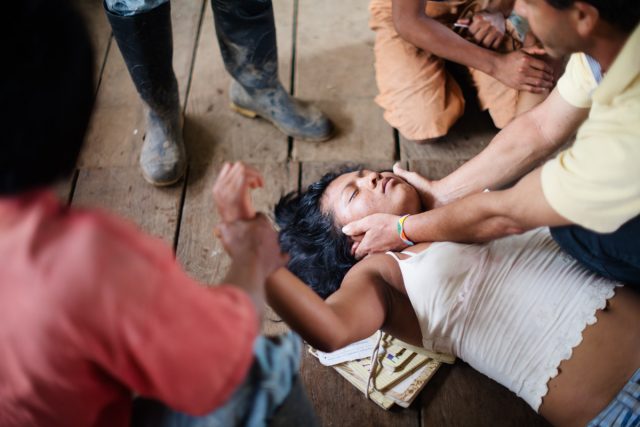We live in a deeply mysterious world. To be sure, one hears a lot about how much we know as a species; we are told that human knowledge is now doubling every thirteen months, and will soon double every twelve hours. Yet our presumptions are being challenged all the time, and much of what we learn tears down old ideas, putting to cinders beliefs that were once taken as gospel. Indeed, mystery is what fires the furnace of discovery: Today, the pharmaceutical companies retrace the steps of witch doctors in the rain forest in search of next year’s miracle drugs; contemporary physics textbooks read like philosophy, or perhaps magic, and this week it was reported that the universe is expanding faster than scientists can explain. Yes, it’s impressive how much knowledge we’ve harnessed as a species, but its those things we don’t know that make the world worth showing up to every day.
One of the odder phenomena I’ve come across recently is that of location-specific illnesses, also known as culture-bound syndromes. The fourth edition of the Diagnostic and Statistical Manual of Mental Disorders (DSM) listed twenty-five such conditions, loosely defined as a set of symptoms considered to be a recognizable disease only within a specific society or culture. Not all of the below make the list, and the consensus on these things is constantly changing; today we’re going to have a look at a few of the more interesting ones.
Paris Syndrome
Perhaps the most well-documented of these maladies is Paris Syndrome. A transient illness known to affect foreign travelers to the French capital, Paris Syndrome causes shortness of breath, dizziness, delusional states and paranoia, and can even produce hallucinations. Tourists from Japan are particularly susceptible to the disease; aside from the exhaustion of travel, there are thought to be a couple of factors behind this. First, very few Japanese speak French, and vice versa, which can intensify the sense of anomie and dissociation felt by a visitor to a foreign country. The second factor is more interesting: because Paris is so idealized in Japanese magazines and film, it is thought that the Japanese are disillusioned when faced with the genuine article. Parisians are depicted in the fashion rags as whip-thin models dressed in the latest couture; of course in reality they are far less glamorous. The French population is also more overweight than the Japanese; apparently it’s all just too much to take.

Paris Syndrome
The Japanese embassy repatriates up to 20 tourists a year suffering from the syndrome, and operates a 24-hour hotline to help those dealing with symptoms. Sadly, there is only one cure: permanent removal from the City of Love.
Jerusalem Syndrome
Next, picture yourself on extended holiday. You’ve toured a handful of European capitals, and the final destination is a special anniversary gift to your wife: a visit to the Holy Land in Jerusalem. All is going well upon arrival; your partner is unusually quiet, but certainly she’s just overwhelmed by the trip, the sights, the history echoing around you. You choose a hotel around the corner from the Church of the Holy Sepulchre, home to the two holiest sites in Christendom: the site of Jesus’ crucifixion, and that of his resurrection.
After a short trip downstairs, you return to an empty room, your wife gone. Strangely, the linens have also been stripped from the hotel bed. You take to the streets in a low-grade panic, and soon you’ve found her, a block away in front of the domed cathedral. Naked beneath the bedsheets, she greets you like a stranger, a rapturous smile on her flushed face. “Jesus,” she tells you. “Jesus is here. Can you feel it?” Your wife is the latest victim of Jerusalem Syndrome.

Modern Jerusalem
About 100 people each year are treated for the malady, and about 40 percent of them require hospitalization. Suspected to arise from the intense experience of seeing Jerusalem, the syndrome may be compounded by the heightened religious zeal one might expect among (at least some) visitors to the Holy Land. From all accounts, Jerusalem is imbued with a palpable sense of the past that can feel oppressive at times, and seeing venerated sites like the Holy Sepulchre and the Wailing Wall for the first time carries a heavy psychic weight for believers and nonbelievers alike. Many, though not all, sufferers have a previous psychiatric history, and the city’s spiritually loaded atmosphere is thought to act as a trigger. Victims of the syndrome often imagine themselves the Messiah; others have been convinced they are the Virgin Mary, or King David. One, convinced he was Samson, tried (unsuccessfully) to lift a section of the Wailing Wall. Though some patients require antipsychotic drugs to fully recover, once again there is only one long-term cure: leave Jerusalem, never to return.
Incredibly, it’s said that a well-known Israeli researcher once arranged for two patients, both of whom claimed to be the Messiah, to be placed in the same room – just to see what would happen. Though the two clearly had much in common, the meeting did not go well. They accused one another of blasphemy and fraud, and hurled vicious curses and threats until separated. So much for turning the other cheek.
Brain Fag Syndrome
A disorder affecting a narrow subset of the West African population, Brain Fag Syndrome (not making this up) causes head and shoulder pain, accompanied by confusion and fatigue. Thought to be related to the stress of studying, it is seen mainly among Nigerian students, particularly those studying in Western school systems.
A phenomenon documented for over a half century, it seems to affect those with greater verbal skills disproportionally, and more than a third of Nigerian students are thought to struggle with brain fag at some point. “Fag” is short for fatigue, but this goes way beyond test anxiety: severe instances of brain fag have been known to bring about intense pain, tachycardia and blurred vision. Researchers suggest the condition may arise from the unique culture clash experienced by a West African student immersed in a Western educational environment. For my part, I’m wondering just how Western this educational environment is, where students unironically call a disease “Brain Fag.”
Grisi Siknis (Crazy Sickness)
For over two hundred years, the Miskito people of Central America have endured periodic outbreaks of a mysterious illness causing delusions, convulsions and in some cases coma. Grisi Siknis seems to spread like a virus among the population, and sends its victims into manic, sometimes violent spells in which they flee their homes, grabbing whatever weapons are at hand to defend against unseen attackers. The afflicted have been said to vomit insects, and are reported to exhibit superhuman strength, often needing to be subdued with ropes and other restraints.

A girl suffers a seizure brought on by Grisi Siknis. Photo credit: Alexander Rieser
According to Miskito tradition, grisi siknis is caused by possession, and is the result of an imbalance between spirits brought on by a malevolent sorcerer. It’s classified by Western psychiatry as a “running” syndrome, characterized by sudden frenzied activity and a pattern of running and exhaustion, along with trance-like states and amnesia. Whatever the cause, in some instances as many as a quarter of a village’s population has become afflicted, and entire towns have been looted during these large-scale grisi siknis outbreaks.
Because of its contagious appearance, researchers have been looking closely at victims’ blood for years, but have found nothing. Various researchers suggest the condition might be caused by the extreme poverty and stress the Miskito people are forced to endure; many link the effects to the sexual awakening of young girls in a traditional, repressive culture (Crazy Sickness affects young females disproportionately, research shows).
As of now, the jury’s still out. Whatever the cause, in some instances as much as a quarter of a village’s population has become afflicted; entire towns have been looted during large-scale grisi siknis outbreaks, which can last months. An epidemic that started in 1910 is said to have lasted for fully twenty years.
Koro
Originally associated with Southeast Asia but found all over the world, Koro is a psychological disorder in which victims (primarily men) become convinced that their genitals are retracting into the body. Likely derived from the Malay term Kura (which means “head of turtle”), Koro induces extreme anxiety, a perceived loss of sexual power and fear of death. Outside short-term effects of the type one might expect when stepping out of a swimming pool, no outwardly visible change can be perceived in the genitalia of sufferers; the change is only in the patient’s mind. In their confusion and distress, victims have been known to tie their penises with string or fix them with clamps, sometimes enlisting family (wish there were another word to use here) members to man the rope in shifts to prevent further retraction. Often this results in injuries, in some cases even death.
Cases of ‘genital retraction syndrome,’ as it is referred to in the West, have been noted in the United States as far back as the 1880’s, and largely consigned to the realm of mass hysteria. That was several decades before koro was known about here, so no one appears to have a monopoly on these phenomena. As in the case of grisi siknis, koro seems to follow populations undergoing systemic change or distress, and to lessen in frequency following an increase in a group’s quality of life. Unsurprisingly, koro’s frequency also appears to increase in communities with a tendency to believe in magic and witchcraft.
Though koro has never killed anyone, the disease has indirectly led to many deaths. Dozens of people have been killed after being accused of shrinking or stealing someone’s genitals, at times lynched in the street by angry mobs. In this way, “penis thievery” episodes at times have resembled the witch hunts of colonial America, also understood through the prism of mass hysteria.
So, what makes one instance mass hysteria, and another a full-blown “syndrome?” It’s evidently not an easy question to answer. Dr. Ronald C. Simons, Professor Emeritus at Michigan University, gave it a shot in Psychiatric Times back in November of 2001: “In theory, culture-bound syndromes are those folk illnesses in which alterations of behavior and experience figure prominently. In actuality, however, many are not syndromes at all. Instead, they are local ways of explaining any of a wide assortment of misfortunes,” he wrote. But in the same piece he concedes that there is some overlap between the two, and the most recent edition of the DSM trimmed the list of culture-bound syndromes to just ten, reflecting psychiatry’s changing attitude toward these maladies.
And what of mass hysteria? When there is no organic cause for a disease, what is it that drives these behaviors? Recently, researchers have been looking at mirror neurons. These are neurons that activate when a person performs an action, and simultaneously sees someone else performing the same action; it’s guessed that they may have evolved in primates to facilitate learning. There appears to be a feedback mechanism built into mirror neurons that prevents us from mindlessly repeating every action we see. Researchers suspect that in incidents of mass hysteria, something goes wrong with this mechanism – turning us into compulsive mimics.
This article is the latest in a series examining the strange, mysterious and unexplained phenomena that make our universe such a wondrous place. Make sure to sign up for our newsletter, and visit us at Joe Content again soon.